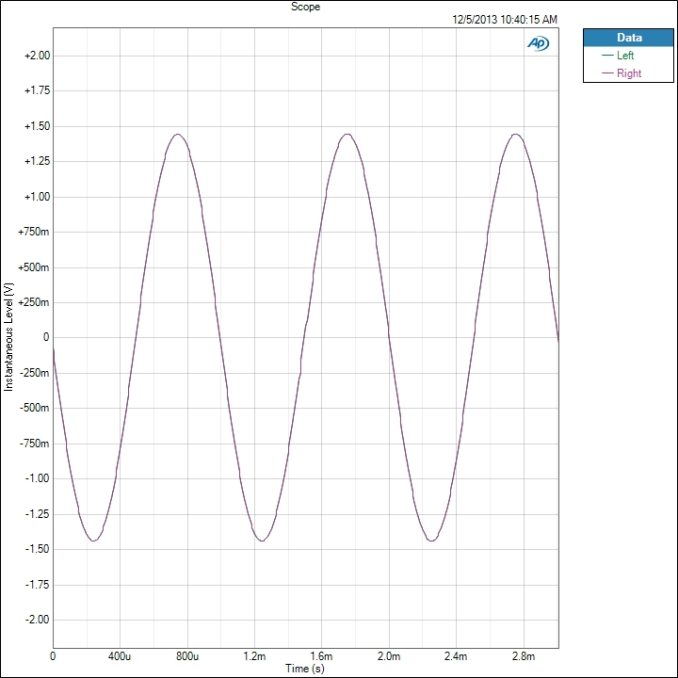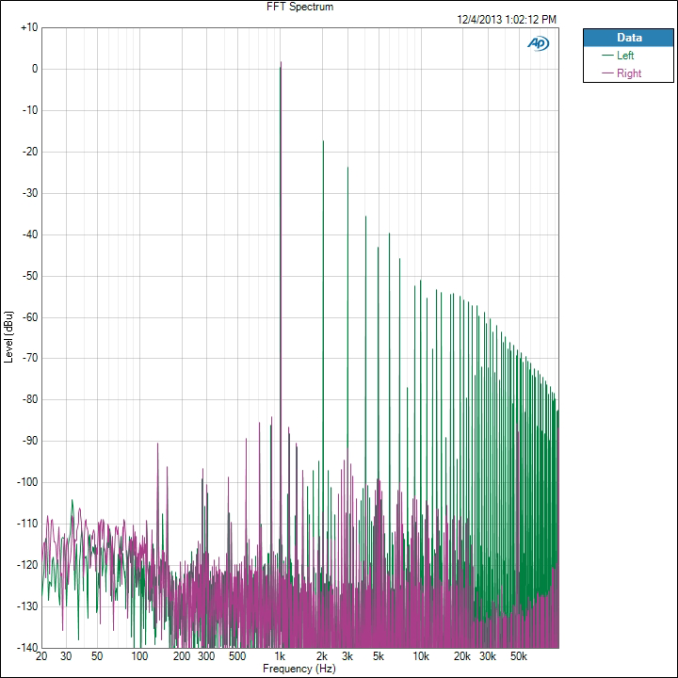Smartphone Audio Quality Testing
by Chris Heinonen on December 8, 2013 5:15 PM EST- Posted in
- Smartphones
- Audio
- Mobile
- Tablets
- Testing
THD+N is a measure of the total harmonic distortion and noise compared to the signal. The lower the number, the less distortion and noise there is relative to the fundamental frequency. THD+N is measured by driving a 1 kHz sine wave at maximum volume. Because there is always some inherent background noise, the THD+N is almost always lowest at maximum output so that is used for the measurement.
There are two results that we take from this: a sine wave and a FFT spectrum. On the sine wave both channels should line up perfectly, and it should be as close to an accurate sine wave as possible. On the FFT we want to see a peak at 1 kHz and everything else as low as possible. The most common artifact you will see are harmonic sidebands at multiples of 1 kHz.
For an example of data that looks good, here is the sine wave of the iPhone 5. We see a sine wave that is good, with channels that overlap perfectly and no deviation. This is what we expect to see.
Now for a different example we look at the Nexus 5. Run at maximum volume we see that the left channel is clipping in the sine wave. Likely the power to the headphone amplifier is not enough to drive both channels and so this is the result. UPDATE: Tested this with 4.4.1 and no change.
The iPhone 5 produces a THD+N ratio of 0.003134% while because of the clipping, the Nexus 5 is producing 13.789197%. Any level over 1% is considered to be past the clipping point of an amplifier and it seems that the Nexus 5 cannot be driven at maximum volume. I tested two samples to verify, and on both the performance is identical.
Now if we look at the FFT for this test, we see how this distortion is showing up. First, the iPhone 5 is very quiet.
There is a 2 kHz peak that is -93 dB below the fundamental frequency, and the 3rd harmonic at 3 kHz is over -109 dB below it. All the harmonics past that are at -120 dB below the fundamental tone. There is some noise out at 50 kHz but this is so far past the level of human hearing that it is safely ignored. Now the Nexus 5 FFT.
We see the right channel, which didn’t clip, looks good. The 2nd harmonic is -111 dB and the 3rd harmonic is -93 dB. On the left channel the 2nd harmonic is only -18 dB and the 3rd harmonic is -24 dB. Even at the 9th harmonic we are still only -52 dB below the fundamental tone. This is causing these incredibly high THD+N numbers that we are seeing on the Nexus 5. We will see more detail of this on a later test as well.
We also chart THD+N vs. Frequency. Here is the chart for the Note 3.
We see that THD+N is basically right below 0.08% for the whole spectrum. It moves up and down slightly, but is very constant. Now here is that Nexus 5 data.
We see that the right channel is around 0.01% THD+N while the left channel, the clipped one, is over 3%. If we ran the Nexus 5 at a lower volume level we would see totally different results, as you’ll find out later, but this is how devices are typically measured.
















188 Comments
View All Comments
Scootiep7 - Wednesday, December 11, 2013 - link
Wonderfully well thought out and written article. Thank you! FFora future article my one request would be for a llcomparrison of all phones on each test parameter instead of only comparing 2 or 3 on some metrics. Again, thank you!qualitycounts - Wednesday, December 11, 2013 - link
Thank you so much for doing this testing. It would also be very helpful if your wrap up section did some side by side comparisons, kind of like they do on Consumer Reports. It's very hard from this article to tell which one comes out on top. Also, it would be nice to see an audio/phone quality report on the HTC One since it is also one of the most popular smartphones available.sergoliv - Wednesday, December 11, 2013 - link
In my opinion, audio quality testing is a very welcome adition to Anandtech. I am maily a classical music listner. Good dynamic range, wide and flat frequency response and capacity to respect all harmonics present in recordings are very important for classic music. Can you broaden your testing to in order to give an idea of what smartphones are more capable with classical music?mike8675309 - Wednesday, December 11, 2013 - link
A major use case for me and my phone is as a spoken language playback device through a speaker (not headphones). Be it podcasts or audible books, a good percentage of my "audio" listening on my phone is via powered "stereo" speakers plugged into the headphone port. Often with the volume on the phone at max so the powered speakers have more range especially if in the garage doing noisy stuff or taking a shower. What if any weight should be placed on these results for such a use case?Additionally, I've historically found phones unable to provide enough power for the various headphones I use (currently Klipsch S4) when using them with mowing the grass or such. Thus I have added a small personal audio amplifier for some uses of my phone and listening to things. In that case I usually have the phone at mid or lower levels and control most of the sound at the amp. Any thought to testing some of the more common portable audio amplifiers?
skynet11 - Wednesday, December 11, 2013 - link
Could you please test on-board speakers in like manner?BobN - Wednesday, December 11, 2013 - link
Anyone know of an app that improves the call quality of the Galaxy S4? I know about Adapt Sound but it doesn't give my phone good phone call sound. Thanks.AnnonymousCoward - Wednesday, December 11, 2013 - link
What a good article. I'd love to see this data for sound cards vs integrated, and MP3 players, using only high quality reference headphones (or speakers).hmaarrfk - Friday, December 13, 2013 - link
Interesting article.From the stepped response, it seems that they are all using 16 bit DACs (16 bits would give you close to 96dB of dynamic range if the only source of noise was quantization for a signal at full power).
Can you confirm this? Does this mean, that having 24 bit encoded music is simply wasteful on a mobile device?
hmaarrfk - Friday, December 13, 2013 - link
Or did you simply use 16 bit audio? Have you tried your tests with 24 bit audio?panda-fu - Thursday, December 19, 2013 - link
24 bit encoded audio for end-user listening purposes has never been shown to have any advantage or difference from 16 bit in double blind tests. The potential advantage of 24 bit DACs lies in being able to use digital attenuation for volume control without losing any dynamic range. However, with proper dithering after attenuation, you have quite a bit of leeway even with a 16 bit one before it gets audible. So, don't worry about that spec!